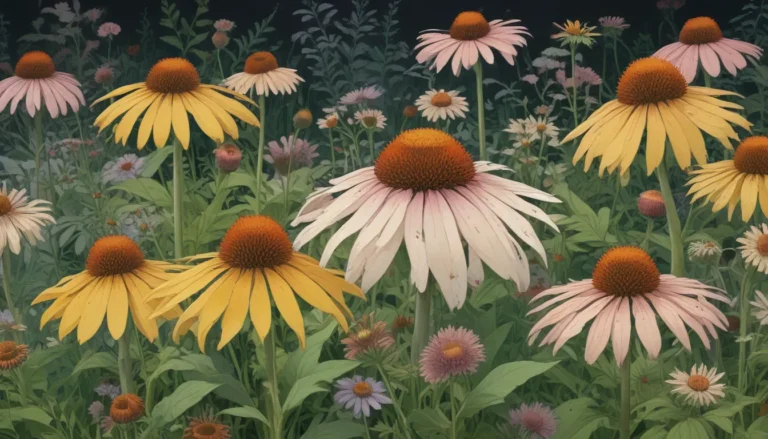How to Plant and Grow Jewelweed in the Garden: A Comprehensive Guide

Jewelweed, also known as touch-me-nots, are vibrant, flowering annuals that have captured the interest of gardeners due to their distinct blooms. In the vast world of impatiens, jewelweed stands out as a wild species that offers a unique charm to gardens. If you are looking to add these lovely plants to your garden, this detailed guide will provide you with all the information you need to successfully plant and grow jewelweed in your outdoor space.
What Is Jewelweed?
Jewelweed, consisting of two species – I. capensis and I. pallida, are native to North America found growing in shady areas in wooded regions. While I. capensis prefers wet, loamy soil, I. pallida can tolerate slightly drier conditions. The name “jewelweed” is derived from the bright, colorful blossoms of these plants, which shine like jewels in a garden setting. However, it’s essential to distinguish them from other impatiens species like Himalayan balsam, which have invasive tendencies.
Anatomy
Visually, jewelweed can be identified by their towering height, reaching between two and five feet, and unique cornucopia-shaped single blossoms with distinctive curved spurs at the end. These plants self-seed prolifically, producing both showy pollinator-attracting blossoms and inconspicuous cleistogamous flowers that form seed capsules which burst open upon touch.
Cultivation and History
Jewelweed has a rich history of traditional uses among indigenous peoples in North America. The watery fluids inside the stems were utilized for treating various ailments and skin conditions. Additionally, the blossoms and seeds of these plants are edible, providing a colorful addition to salads and dishes. They are highly attractive to pollinators and wildlife, making them a beneficial addition to any garden. Cultivating jewelweed in your garden will not only enhance its beauty but also support local ecosystems.
Propagation
Jewelweed is a self-propagating plant that readily reseeds itself, making it low-maintenance in terms of propagation. However, if you prefer to start seeds indoors, the process can be simple and rewarding. Collecting seeds from wild sources and providing cold stratification before planting them outdoors can help ensure successful germination. Proper care and attention during the propagation process will set the foundation for healthy jewelweed plants in your garden.
From Seedlings/Transplanting
Transplanting seedlings to their permanent outdoor location should be done with care to avoid damaging the fragile stems. Providing adequate spacing, moisture, and sunlight will promote healthy growth and development in jewelweed plants. After establishing them in the garden, minimal maintenance is required to ensure their continued health and vibrancy.
How to Grow
For successful growth, plant jewelweed in shady locations with moist, loamy soil. Yellow jewelweed can tolerate slightly drier conditions compared to the orange variety. Offering an environment that mimics their natural woodland habitat will promote healthy growth and abundant blooms. Regular watering, appropriate spacing, and nutrient-rich soil are essential factors in cultivating vibrant jewelweed plants in your garden.
Growing Tips
- Provide loamy soil and adequate moisture, with slightly less water for yellow jewelweed.
- Plant in a shady location with limited direct sunlight exposure.
- Avoid planting too closely to other garden plants to prevent competition.
Maintenance
Minimal pruning is recommended for jewelweed to maintain optimal bloom production. Providing shade, moisture, and ample space for growth are key factors in maintaining healthy jewelweed plants throughout the growing season. At the end of the season, allowing the plants to self-sow can promote natural reseeding for continued growth in the following seasons.
Where to Buy
Ready to add jewelweed to your landscape? Earthbeat Seeds offers I. capensis seeds in convenient packets for easy planting.
Managing Pests and Disease
Jewelweed is relatively resistant to pests and diseases, with aphids and midges being occasional nuisances. Proper monitoring and timely intervention can help mitigate any issues that may arise. Maintaining a healthy growing environment and supporting beneficial wildlife can contribute to the overall well-being of jewelweed in your garden.
Herbivores
Deer are known to be primary defoliators of jewelweed, while birds and rodents may occasionally browse on the seed pods. Implementing preventive measures or allowing natural seed dispersal can help manage potential herbivore-related concerns.
Insects
Aphids and midges are common pests that may affect jewelweed plants. Utilizing neem oil or insecticidal soap can help control these pests while minimizing harm to beneficial insects and pollinators.
Disease
Impatiens capensis is highly resistant to disease, with rust being a rare occurrence that usually resolves on its own. Monitoring for signs of disease and promptly addressing any concerns can help maintain the health and vitality of jewelweed plants in your garden.
Best Uses
Jewelweed is ideal for borders, mass plantings, and pollinator-friendly garden spaces. Planting them near boggy areas or water features can maximize their growth potential and aesthetic appeal. Pairing jewelweed with other shade- and moisture-loving plants can create a harmonious ecosystem that supports local wildlife and pollinators.
Quick Reference Growing Guide
- Plant Type: Annual flower
- Flower/Foliage Color: Orange or yellow/green
- Native to: North America
- Hardiness (USDA Zone): 3-10
- Water Needs: Moderate to high
- Bloom Time: Spring, summer
- Exposure: Full to partial shade
- Spacing: 18-24 inches
- Height: 2-5 feet
- Spread: 2-4 feet
- Growth Rate: Fast
- Tolerance: Shade, wet soil, boggy conditions
- Maintenance: Low
- Attracts: Bees, butterflies, moths, wasps
Adding jewelweed to your garden or landscape can enhance its beauty and ecological value. By incorporating these native species into your outdoor space, you can create a vibrant and sustainable ecosystem that supports local wildlife and pollinators. Whether used as borders, pollinator forage, or decorative displays, jewelweed is a versatile and beneficial addition to any garden setting.
Are you planning to add jewelweed to your garden? Share your thoughts and experiences in the comments below!





